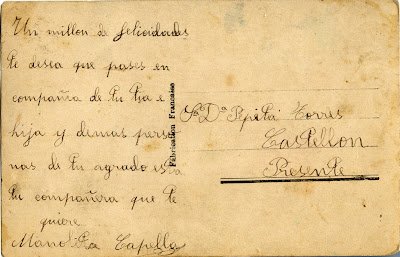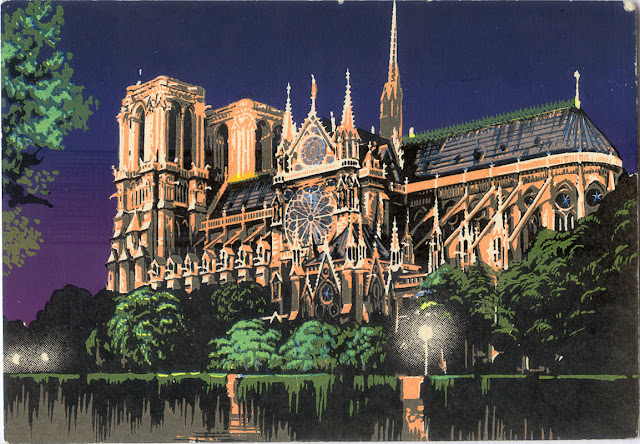Tarjeta postal de 88 x 139 mm. Fototipia de la Colección " Excelsior " de editor desconocido con la imagen del Sepulcro del Infante D. Alonso en la Cartuja de Burgos, escultura gótica que fue realizada por el escultor castellano Gil de Siloé ( http://es.wikipedia.org/wiki /Cartuja_de_Miraflores ). La fotografía ocupa todo el anverso excepto unos 20 mm de la parte inferior donde aparece la leyenda diciendo el motivo y dejando un pequeño espacio en blanco para poder escribir.
El reverso aún no está dividido por lo que esta postal fue editada antes de 1905, figura la leyenda en tinta roja:
"Unión postal Universal
Unión Postal Universal
España"
La persona que escribe y envía esta tarjeta postal lo hace en el año 1911, fecha en la que sí estaba autorizado divide el reverso para destinar la parte izquierda al mensaje y el derecho a la dirección por lo quela división la hace con una línea a lápiz . Esta postal ha circulado y poseía franqueo que ha sido arrancado de su lugar quedando restos del matasellos aunque no es legible el lugar de procedencia (podría ser Burgos por ser una postal de allí aunque no es seguro).
Va dirigida a la "Srta Pepita Méndez Rodríguez-Acosta, San Antón 28, Granada" .
El segundo apellido (Rodríguez-Acosta) pertenece a una conocida e influyente familia de Granada de banqueros que contó entre sus miembros con el pintor José Mª Rodríguez-Acosta de la Cámara (1878-1941), actualmente existe en Granada la fundación Rodríguez-Acosta. que difunde su obra y la cultura en general ( http://www.fundacionrodriguezacosta.com ).
El texto incompleto de esta tarjeta postal (hay partes difícilmente legibles) dice lo siguiente:
"1 Agosto 1911. Querida Pepita: Mucho agradecí tu celebración pues veo te acuerdas de mí, yo también os recuerdo con mucha frecuencia. El l unes estuvimos en Granada y fuimos al Colegio, nos dijo la Mª Superiora que al papá de Concha ________ le Había dado otro ataque y ella se había tenido que volver a Madrid. Yo no la había escrito por no saber las señas ____ tú la escribes.
Muchos recuerdos a tus hermanas ya tu sabes, te quiere mucho Carmen."
Parte del texto está escrito en el reverso en dirección horizontal y luego superpuesto en dirección vertical, luego continúa en el anverso encima de la imagen y finaliza en la parte blanca inferior.
Del texto se deduce que ambas (Carmen la remitente y Pepita la destinataria) asisten a un mismo colegio, con internado, de la ciudad de Granada del que no se da el nombre y que regenta una orden religiosa, deben de estar de vacaciones y por ello se escribe, se habla de una amiga común (Concha) que ha regresado a Madrid por enfermedad de su padre. Casi al final del texto, en la despedida, da muchos recuerdos a las hermanas de Pepita ya " tu sabes " que debe ser un hermano o familiar cercano del que ella es admiradora. Deben de ser adolescentes, la letra es ya de persona mayor pero aún están en el colegio. Utilice la palabra "señas" para referirse a la dirección de una persona, recepción que actualmente está en desuso.
Esta tarjeta postal fue comprada en un mercadillo por 300 pesetas (1,80 €). Tarjeta postal bien conservada.











